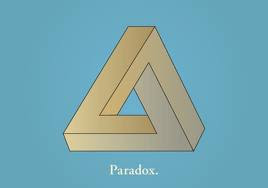Friday, June 1, 2012
Foundational Crisis In Mathematics
Between Syntax And Arithmetic
Gödel’s Incompleteness Theorem-Reciprocal Movement
Divergencies, convergencies and, at times, insurmountable paradox, has marked the history of mathematics. A major discontinuity in the history of mathematics occurred in the l880’s when Georg Cantor developed his theory of sets. Cantor developed a diagonal method from which he worked out the mathematics of infinities. The essence of this method is, according to Douglas Hofstadter, “the fact of using one integer in two different ways--or, one could say, using one integer on two different levels--thanks to which one can construct an item which is outside of some predetermined list.” [Douglas R. Hofstadter, Gödel, Escher, Bach: an Eternal Golden Braid, 1979, p. 423]
The diagonal method developed by Cantor was not the problem, rather, the controversy sprang from what Cantor was able to prove with this method. For instance, in his investigations into non-denumerable sets Cantor was able to prove:
“Any line segment, no matter how small, contains as many points as an infinite straight line. Further, the segment, contains as many points as there are in an entire plane, or in the whole of space of n dimensions (where n is any integer greater than zero) or finally in a space of denumerable infinite number of dimensions.” [E.T. Bell, Men Of Mathematics, 1937, p571]
By bringing into question the fundamental axioms such as: every magnitude is equal to itself; the part is less than the whole; two magnitudes, equal separately to a third, are equal to each other; etc., Cantor’s transfinite mathematics brought the very foundation of mathematics into question.
Three foundational schools of mathematics arose in response to Cantor’s transfinite mathematics. Each produced their own point of view concerning the nature of number. Bertrand Russell advocated that mathematics could be reduced to a system of logic while the school of thought representing intuitionalism accepted number as a “given”. Kronecker, a spokesperson for the intuitionalist school, is reported to have said, “The whole numbers were made by the good Lord, everything else is the work of man.” [A.S. Luchins and E.H. Luchins, Logical Foundations of Mathematics for Behavioral Scientists, 1965, p.56] Not surprisingly the intuitionalists took exception to many of the concepts associated with the mathematics of infinitesimals.
In an attempt to end the controversy over number, the third foundational school, the formalists (Hilbert), set themselves the task of creating an axiomatic language (using methods acceptable to both logists and intuitionalists) that would define a formal number-theoretic system (a system inclusive of the natural numbers, analysis and calculus). If successful, this axiomatic language would have been both consistent and complete and it would have eliminated the paradoxes and antinomies that were found in set theory and classical mathematics. For better or worse, the formalist school of thought did not achieve their goal. What was achieved however was a 1931 paper by Kurt Gödel which determined the goals of the formalist approach to mathematics to be unattainable. In his paper, entitled, On Formally Undecidable Propositions of TNT (typographical number theory) and Related Systems, Gödel offered a proof which demonstrated that given any sufficiently powerful formal system, it is not possible for it to be complete and, while it may be consistent, its consistency is not provable within the system.
Subscribe to:
Post Comments (Atom)






No comments:
Post a Comment